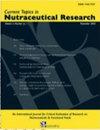Optimization of Ultrasonic-Assisted Extraction of Flavonoids from Ilex Latifolia Thunb by Response Surface Methodology and their Influence over the Activity of Xanthine Oxidase
IF 0.4
4区 医学
Q4 NUTRITION & DIETETICS
引用次数: 0
Abstract
We have examined the ultrasonic ethanol extraction of Ilex latifolia Thunb flavonoids and the inhibitory effect of these flavo¬noids on xanthine oxidase. Four single-factor extraction conditions were examined: ethanol concentration (%), solid–liquid ratio (g/mL), ultrasonic extraction temperature (°C), and ultrasonic extraction time (min). With these data, the response surface methodology was adopted to optimize the ultrasonic extraction parameters. The optimal ultrasonic extraction parameters were determined to be the ethanol concentration of 49%, the solid-to-liquid ratio of 1:27, the ultrasonic extraction temperature of 74°C, and the ultrasonic extraction time of 97 min. Under the optimal conditions described ear¬lier, the experimental yield of flavonoids was 6.367% with a relative standard deviation of 1.9%, which was comparable to the theoretical extraction rate. The half maximal inhibitory concentration of flavonoids for xanthine oxidase is 5.50 mg/mL. The inhibitory effect was competitive and reversible, with an inhibitory kinetic constant Ki of 2.35 mg/mL.响应面法优化超声辅助提取黄酮类化合物及其对黄嘌呤氧化酶活性的影响
我们研究了超声波乙醇提取冬青类黄酮的方法,以及这些类黄酮对黄嘌呤氧化酶的抑制作用。考察了四个单因素提取条件:乙醇浓度(%)、固液比(g/mL)、超声提取温度(°C)和超声提取时间(min)。利用这些数据,采用响应面法对超声提取参数进行了优化。确定了最佳超声提取参数为乙醇浓度49%,固液比1:27,超声提取温度74°C,超声提取时间97分钟。在上述最佳条件下,黄酮类化合物的实验产率为6.367%,相对标准偏差为1.9%,其与理论提取速率相当。黄酮类化合物对黄嘌呤氧化酶的半数最大抑制浓度为5.50mg/mL。抑制作用具有竞争性和可逆性,抑制动力学常数Ki为2.35 mg/mL。
本文章由计算机程序翻译,如有差异,请以英文原文为准。
求助全文
约1分钟内获得全文
求助全文
来源期刊
CiteScore
1.10
自引率
0.00%
发文量
36
审稿时长
>12 weeks
期刊介绍:
Current Topics in Nutraceutical Research is an international, interdisciplinary broad-based peer reviewed scientific journal for critical evaluation of research on chemistry, biology and therapeutic applications of nutraceuticals and functional foods. The major goal of this journal is to provide peer reviewed unbiased scientific data to the decision makers in the nutraceutical and food industry to help make informed choices about development of new products.
To this end, the journal will publish two types of review articles. First, a review of preclinical research data coming largely from animal, cell culture and other experimental models. Such data will provide basis for future product development and/or human research initiatives. Second, a critical evaluation of current human experimental data to help market and deliver the product for medically proven use. This journal will also serve as a forum for nutritionists, internists, neurologists, psychiatrists, and all those interested in preventive medicine.
The common denominator of all of the topic to be covered by the journal must include nutraceuticals and/functional food. The following is an example of some specific areas that may be of interest to the journal. i) Role of vitamins, minerals, antioxidants and phytonutrients on cardiovascular health, cancer, diabetes, ocular health, mental health, men’s health, women’s health, infant nutrition, ii) Role of herbals on human health, iii) Dietary supplements and sleep, iv) Components of diet that may have beneficial effect on human health, v) regulation of apoptosis and cell viability, vi) Isolation and characterization of bioactive components from functional foods, vii) Nutritional genomics, and viii) Nutritional proteomics.

 求助内容:
求助内容: 应助结果提醒方式:
应助结果提醒方式:


